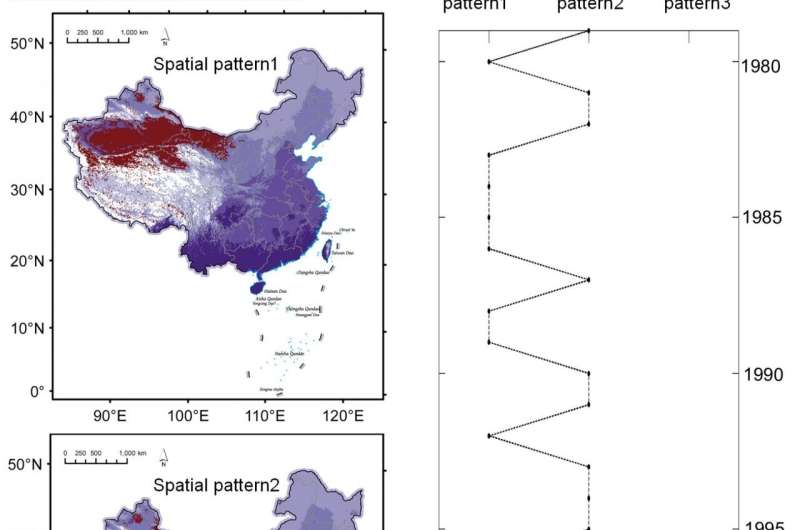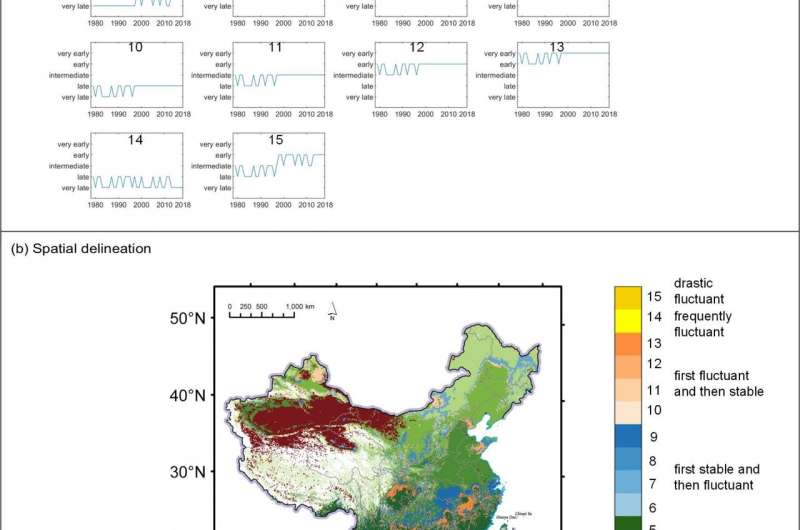Scientists analyze spatio-temporal differentiation of spring phenology in China from 1979 to 2018

Spatial and temporal differentiations are important features in the study of phenology of ecosystems. Plant phenology studies the lifecycle phases in plants driven by environmental factors, and the study of its long-term patterns and dynamics is important to reveal the responses of vegetation in different regions of China to global changes.
By partitioning data elements into groups and considering them at an abstract level, clustering is one of the most widely used methods to study the spatio-temporal differentiation of phenology. However, differentiations identified by only using spatial clustering are incapable of illustrating the time-varying behavior in the phenology and vice versa. Recent research used a co-clustering analysis to explore spatio-temporal differentiation of spring phenology in China.
The recently published paper in SCIENCE CHINA Earth Science, "Spatio-temporal differentiation of spring phenology in China driven by temperatures and photoperiod from 1979 to 2018," was written by Professor Cheng Changxiu, Professor Song Changqing and Dr. Wu Xiaojing of Beijing Normal University. The researchers analyzed the long-term first bloom dates (FBD) dataset in China using the Bregman block average co-clustering algorithm with I-divergence (BBAC_I) and Extended spring indices (SIx), and the result revealed the spatio-temporal differentiation of spring phenology in China of the recent 40 years (1979-2018).
The results showed three spatial patterns of FBD in China: Spatial patterns 1-3 represent three typical patterns of FBD during the movement from the South to North of China. Their temporal dynamics for 40 years (1979-2018) can be divided into 3 time periods: (1) Early stage (1978-1996): spatial patterns of FBD in China vary between Spatial pattern 1 and Spatial pattern 2, in which areas located in Jiangxi, northern Xinjiang and middle Inner Mongolia experienced the trend of fluctuant increasing spring onsets; (2) Middle stage (1996-2012): spatial patterns of FBD in China vary between Spatial pattern 2 and Spatial pattern 3, in which areas located in Fujian, Hunan and eastern Heilongjiang exhibited the trend of fluctuant increasing spring onsets; (3) Late stage (2013-2018): spatial patterns of FBD in China stayed at Spatial pattern 3.

The research also displayed 15 temporal patterns of spring phenology over the study period and their spatial delineation in China. These temporal patterns can be divided into five categories according to the changing state of FBD: stable, first stable and then fluctuant, first fluctuant and then stable, frequently fluctuant, and drastically fluctuant. According to the spatial delineation, most areas in China belong to the stable state (green region), while northern Guizhou, Hunan, southern Hubei (blue region) belong to the state of first stable in 1979-1997 and then fluctuant; areas of eastern Sichuan, southeastern Hunan and northern Jiangxi (orange region) belong to the state of first fluctuant in 1979-1997 and then stable.
Results of this research revealed the spatio-temporal differentiation of spring phenology in China for the past 40 years by displaying the spatial patterns of FBD and their temporal dynamics, temporal patterns of FBD, and their spatial delineation. Furthermore, the results have certain directive significance on the design of existing observational sites in the Chinese Phenological Network.
More information: Xiaojing Wu et al, Spatio-temporal differentiation of spring phenology in China driven by temperatures and photoperiod from 1979 to 2018, Science China Earth Sciences (2020). DOI: 10.1007/s11430-019-9577-5
Journal information: Science China Earth Sciences
Provided by Science China Press




















